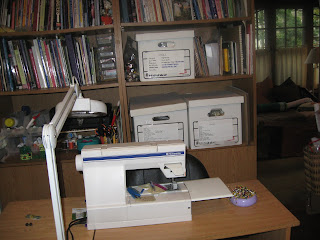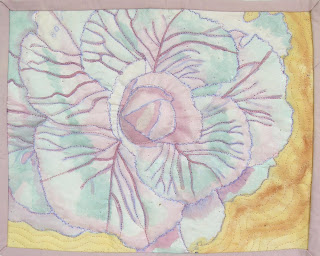Today I took advantage of a period of enforced home confinement, courtesy of Hurricane Irene, to clean out and reorganize my tiny work space. It's a pain in the buttsky job, but one I knew I needed to do to get ready for some upcoming obligations: in November and December, a group show with other members of Women Against the Grain at the Farmington Valley Art Center; and in May 2012, my own solo show at UConn Health Center.
I want to create a series of smaller works for the Farmington Valley Art Center and a few dramatic, larger works for the UConn Health Center.
To clear the decks for that upcoming body of work--stand by for a preview--I needed to focus on the efficiency of my use of my limited storage space, inventorying the contents of my system of cabinets and boxes, consolidating like with like, and reviewing my stock of supplies like Pebeo Setacolor paints and finely woven pima cotton. By doing that, I minimized the amount of distraction created by clutter, disorganization, and supply interruptions.
Oh, I was virtuous.
 |
| Inventoried, reorganized, streamlined, consolidated |
 |
| Order imposed |
|
|
In the process, I looked through my box labeled Notions, the contents of which include shower curtain rings, drapery hooks, cording, elastic, and velcro.
Why do we call miscellany like this "notions"? The departed department stores of the sixties, like the Edward J. Malley Company in New Haven, where I shopped in my high school and college years, had notions departments where customers could find things like emergency sewing kits and padded hangers. Why notions?
The Oxford English Dictionary, of which I have a two-volume set from my days as a graduate student at Ohio State, gives this as definition #9: "articles or wares of various kinds, forming a miscellaneous cargo," using the following quotation as an example of that usage: "A cargo of fresh provisions, mules, tin bake-pans and other notions," Richard Henry Dana,
Before the Mast.
Now that I cleared that up.
Here's a peek at some of the goodies I'm planning on making over the next few weeks and months:
How about this little display? This will be for the Farmington Valley Art Center Show. I'll print this photo on fabric, make it the centerpiece of a quilt, and call it Deconstruction. Why not? The deck is full of squirrel detritus from our Norway spruces: partially-eaten cones and their scales.
 |
| It's not like I don't sweep the deck. These conifer scales fall like snow, courtesy of the squirrels above. Question of the day: do pine cones taste to squirrels the way artichokes, which they so resemble, taste to us? |
Just for fun, I'm going to add some real scales from the cones. To that end, I gathered a bunch of them the other day and dropped them into a solution of warm glycerine and water.
and I'm drying them out on a piece of paper towel:
Once these cone scales are dry, I'll paint them with polyurethane before using them in the quilt. I'll puncture each one with an awl and sew them on by hand. They'll dribble down from the pile of scales in the photo.
For the UConn Health Center, I'm planning a group of larger works, such as a series called Penwood Long Blue Shadows, which will include images such as the following:
I'm going to make the long blue shadows with painted stiffened cheesecloth. I can hardly wait.
Anticipation of projects like these gave me the incentive I needed to get through this major workspace inventory and upheaval today. In the process, I came across a few mystery items, like these white plastic objects:
Who can tell me what they are? They look like some sort of end caps.
I think I'll save them for end times.













